Acer V7-482PG-9884 Review: Everything You Need
by Jarred Walton on August 24, 2013 12:00 AM ESTAcer V7-482PG General Performance
We’ll start with the usual selection of system benchmarks to show how the V7 handles everyday tasks. I don’t have a full set of results for some things, but let me just start with some general OS numbers. The V7 boots reasonably quickly – 23 seconds from power on – and it resumes from hibernate faster – around 15 seconds. Shutdown/hibernate times are typically 11-13 seconds, but unless you need to make sure the system is off before walking away/stowing it in a bag, or if you’re rebooting, I don’t find the time to shut off/hibernate to be particularly important. The boot times are definitely one area where Windows 8 has greatly improved over previous versions of the OS.
Moving on, before we get to the graphs I want to provide a quick overview of our comparison points. As usual, you can find all of the benchmark results for the V7 in Mobile Bench, along with previously tested laptops, so you can always make your own comparisons. Our selection of laptops this time is a bit more varied, as the V7 is both an Ultrabook as well as a potential gaming laptop. From the Ultrabook side of things, this is actually our first full review of a Haswell Ultrabook, so we have to return to Ivy Bridge for most of these comparisons. I’ll include the numbers that we have from the Acer S7-392 preview, but it’s not in all the charts; I’ll also include the Acer R7, Clevo W550EU, HP Spectre XT TouchSmart, and Toshiba KIRAbook. From the gaming side, we’ll include the MSI GE40, MSI GX60, MSI GT70, and the Razer Blade 14; all of these are higher-end gaming notebooks that don’t necessarily compete directly with the V7, but it’s sometimes useful to see what you give up – or in some cases don’t give up – in performance.
| Overview of Comparison Laptops | ||||||
| Laptop | CPU | GPU | Storage | RAM | LCD | Battery |
| Acer R7-571-6858 | Intel Core i5-3317U | HD4000 | 500GB HDD + 24GB SSD | 1x4GB + 1x2GB | 15.6” 1080p Glossy AHVA Touchscreen | 4-cell 54Wh |
| Acer S7-392-9890 (Preview) | Intel Core i7-4500U | HD4400 | 2x128GB RAID 0 SSDs | 2x4GB | 13.3” 1080p Glossy IPS Touchscreen | 4-cell 46Wh |
| Acer V7-482PG-9884 | Intel Core i7-4500U | GT750M DDR3 / HD4400 | 1TB HDD + 24GB SSD | 1x4GB + 1x8GB | 14” 1080p Glossy AHVA Touchscreen | 4-cell 54Wh |
| Clevo W550EU (Mythlogic) | Intel Core i5-3340M | HD4000 | 256GB SSD | 2x4GB | 15.6” 1080p Matte IPS | 6-cell 62-Wh |
| HP Spectre XT TouchSmart | Intel core i7-3517U | HD4000 | 500GB HDD + 32GB SSD | 2x4GB | 15.6” 1080p Glossy IPS Touchscreen | 4-cell 48Wh |
| MSI GE40 | Intel Core i7-4702MQ | HD4600 / GTX760M | 128GB SSD + 750GB HDD | 1x8GB | 14” 1600x900 Matte TN | 6-cell 65Wh |
| MSI GT70 Dragon | Intel Core i7-4700MQ | HD4600 / GTX780M | 128GB SSD + 750GB HDD | 4x8GB | 17.3” 1080p Matte TN | 9-cell 87Wh |
| MSI GX60 | AMD A10-5750 | HD8650G / HD7970M | 750GB HDD | 1x8GB | 15.6” 1080p Matte TN | 9-cell 87Wh |
| Razer Blade 14 | Intel Core i7-4702HQ | HD4600 / GTX765M | 256GB SSD | 2x4GB | 14” 1600x900 Matte TN | 6-cell 70Wh |
| Toshiba KIRAbook | Intel Core i7-3537U | HD4000 | 256GB SSD | 2x4GB | 13.3” 2560x1440 Glossy IPS Touchscreen | 4-cell 52Wh |
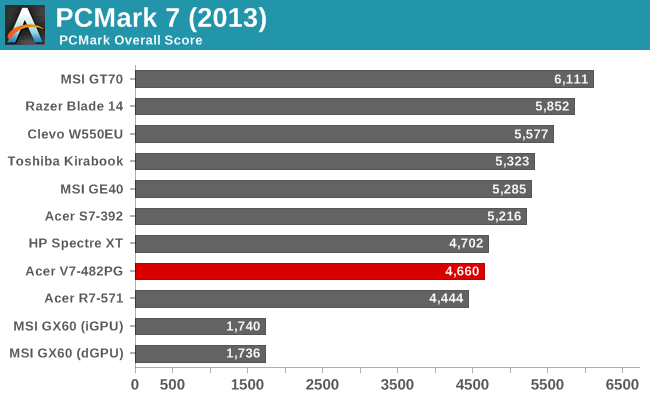
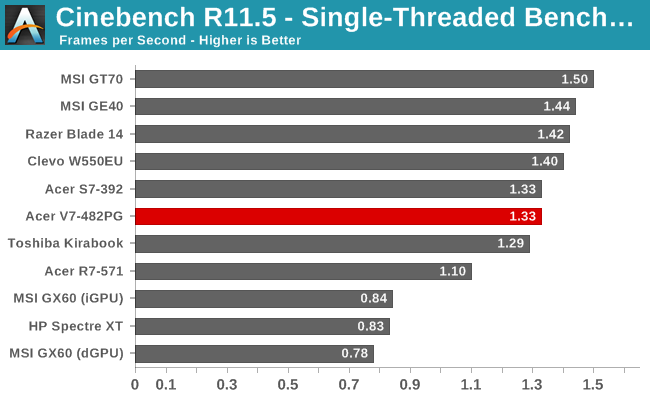
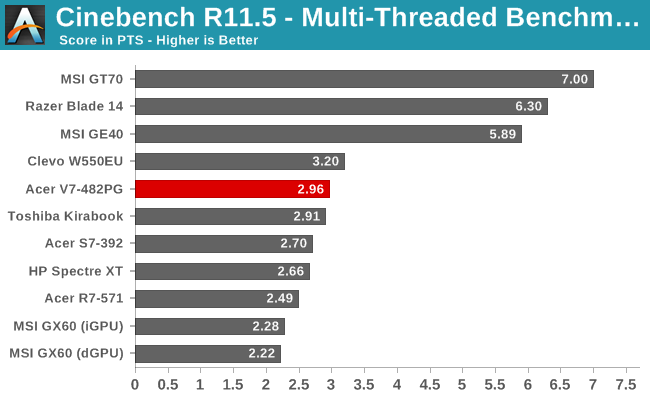
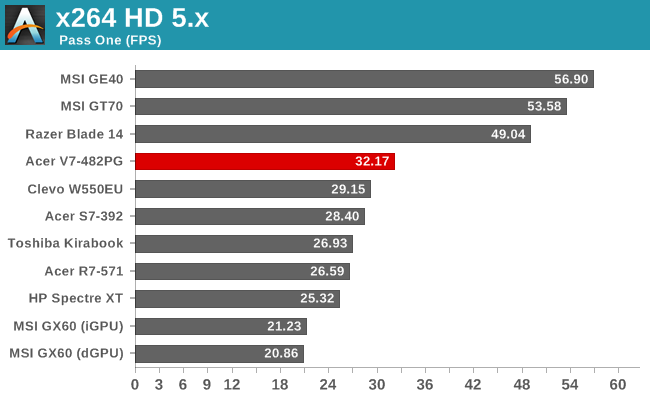

Starting as usual with PCMark 7, obviously the MSI GX60 is seriously penalized by not having a solid state drive. The rest of the systems all come together, with quad-core SSD systems at the top, followed by the dual-core SSD systems, and bringing up the rear we have hybrid SSD + HDD laptops like the Aspire V7. Personally, I find that hybrid storage feels a little closer to pure HDD than it does pure SSD, and benchmarks like PCMark 7 tend to paint a rosier picture than reality. Still, hybrid storage is far better than not having any solid state storage at all. For general use, the fact is that just about any modern system is more than fast enough – and other than a few specific use cases, a solid state drive doesn’t make your system two or three times faster, but it’s still definitely something I want to have in any modern system.
Our next set of performance benchmarks put more of the strain on the CPU, and here we see something that most of us already expected: Haswell isn’t substantially faster than Ivy Bridge. It seems like cooling and thermal throttling (or in other words, bios and firmware optimizations) can have a larger impact on performance than the choice of CPU. For example, the Toshiba KIRAbook and HP Spectre XT have virtually the same Core i7 Ivy Bridge CPU, but the Spectre XT ends up being substantially slower. In terms of where Haswell sits, the i7-4500U comes out ahead of all of the Core i7 ULV Ivy Bridge CPUs, but the difference ranges from a negligible 2-3% in Cinebench to a slightly more noteworthy 8-20% in x264 HD. How much of the difference in x264 is from IPC improvements and how much of it is just a question of BIOS/firmware differences is difficult to say – keep in mind that the Acer S7-392 has the same CPU, so firmware is probably the bigger factor.
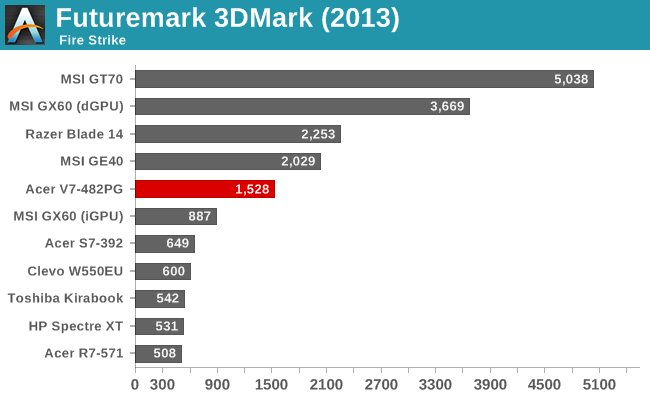
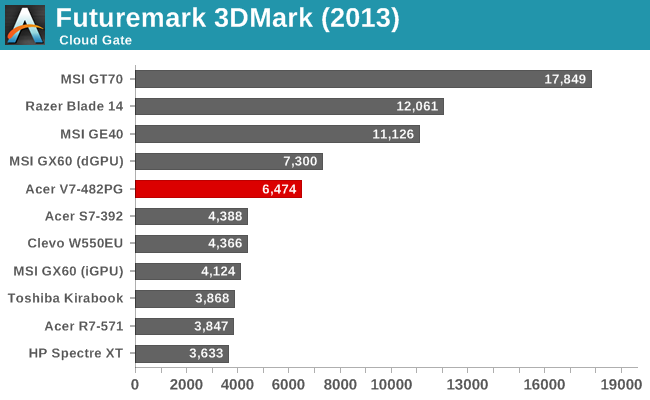
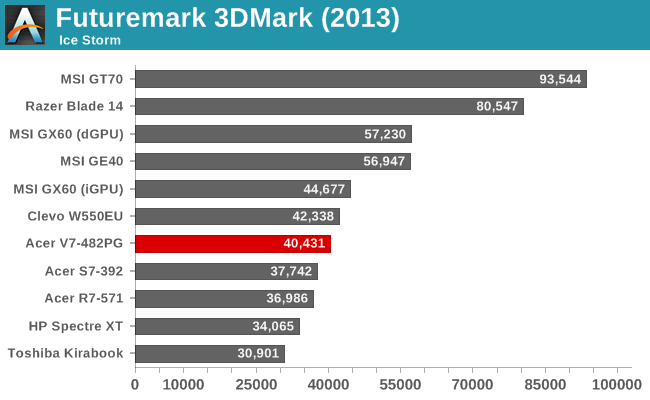
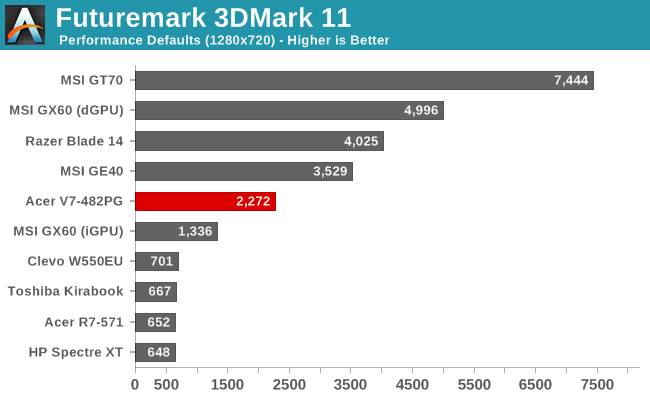
In terms of graphics performance, using 3DMark as our baseline estimate, there’s clearly a pecking order established: high-end GTX and HD 7900 GPUs, moderate GTX 760 GPUs, the GT 750M used in the V7, AMD’s Richland/Trinity iGPU, and then all of the Intel integrated graphics solutions. I’m still surprised that the GT2 implementations of Haswell haven’t really improved over the GT2 Ivy Bridge iGPU, but variations in clock speed certainly play a role. We should also be getting our first Crystalwell (Haswell GT3e) laptop in the next week, which of course will improve performance quite a bit but at a pretty hefty price. Depending on how much OEMs have to pay NVIDIA for something like the GT 750M, and considering the lack of GT3e on dual-core parts, I suspect we might end up waiting for Broadwell for a truly compelling mainstream iGPU from Intel.
And with that said, let’s move on to gaming benchmarks.










62 Comments
View All Comments
JarredWalton - Saturday, August 24, 2013 - link
The "silliness" was more in reference to the hidden torx screws under the pads. Let me clarify that in the text.evilspoons - Saturday, August 24, 2013 - link
Yes! Torx screws are better given the same physical size, and the screwdrivers aren't exactly expensive or anything. I'd much rather have to spend an extra five minutes finding a Torx driver than strip out a friggin' Philips.KaarlisK - Saturday, August 24, 2013 - link
In 2011, I bought a laptop that weights 1.7kg and has a 35W TDP CPU, and as a result, the CPU and the integrated graphics could actually both boost at the same time.Now we're being offered 1.9-2.5 kilo laptops with 17W CPUs and rather inconsistent performance, especially in games.
It seems silly, especially since the idle power consumption is the mostly same and the prices, at least for Ivy Bridge, were mostly similar.
mtoma - Saturday, August 24, 2013 - link
I think Jarred (and many other ethusiasts) have huge expectations from the displays. Sure, everybody wants 1080p (or higher) IPS displays, but at what cost? Let's not forget that many people don't have many thousands of dollars per month in order to afford such beautiful displays/products. For example, why should'nt be enough an 720p or IPS panel on a 14 or 15 inch laptop? I remember back in 2007 I had an 15,6 inch Fujitsu laptop with a 1280x800 pixels. It wasn't great at all, but it was getting the work done. Remember, a greater display resolution demands much more from the graphichs, and that leads to bigger power consumption. More doesn't always mean better.Regards,
KaarlisK - Saturday, August 24, 2013 - link
A better display is simply _the_ worthwhile upgrade in the era of "good enough" computing.I have a Sandy i3 laptop and a Core 2 Duo desktop, and since I do not much game (or convert videos/run scientific simulations), I still do not feel a need to upgrade my CPU (I do have fast storage and lots of RAM).
More and more I've been catching myself on the thought that my next upgrade might be a ~24'' monitor with high DPI, if one arrives for a reasonable price. With the laptop it is similar – it does everything it is asked to, so the only incentive to upgrade is either a way better screen (better colors and high DPI), or the same performance and OS support in a tablet/phone sized package.
sheh - Saturday, August 24, 2013 - link
Nevermind the resolution, a poor TN is a horrible thing. I'd want laptop makers to use *decent* TNs as minimum, though really I'd prefer something better than TN (with decent response pixel times).I recently got an Asus 15.6" laptop (500-600$ in the US). The TN screen is horrendous. The specs say it's something like 15+30 degrees vertically, but that's a lie. It's more like 0 degrees. There's no single angle where you can see the whole screen undistorted. Maybe if you watch it from 2-3 meter away. Horizontal angles aren't good either, but are less of a problem. I wonder why they don't rotate the panel 90 degrees, as vertical is more important in laptops. The 6-bit dithering is not difficult to notice. The pixel response time isn't too good. And looking at technical specs, it seems there are even worse TN screens being made!
Now, you can get such panels on eBay for about $50. That's for a very poor 6-bit 1366x768 TN. For $150 you can get a 15.6" 1920x1080 S-IPS 10-bit. $100 difference in end user price going from super poor to very good:
http://www.ebay.com/itm/New-15-6-Laptop-LCD-Screen...
You can probably find decent 6-bit 1366x768 IPSes for less than $100.
sheh - Saturday, August 24, 2013 - link
BTW, I didn't say anything about contrast because I don't know what it is. The contrast is variable across the screen (mostly vertically), as are the colors (is this pink or orange? is it dark purple or light? is there a vertical gradient here or is it a solid color?).Pfffman - Saturday, August 24, 2013 - link
I don't think Jarred expects people to buy laptops monthly let alone every year so investing in a nicer screen is still reasonable.When the asking price for the laptop is $1300, 1080 would seem to be expected. Touch is a nice extra. Generally Anandtech will scale their screen expectations according to price. They do have a high emphasis on screen though. They generally only okay TN panels if they are the really good ones or the laptop is clearly budget targeted.
In this time, it might be hard to get a 1280x720 or 1280x800 IPS screen at 14 inch. The panel manufacturers might not bother with it any more.
piroroadkill - Sunday, August 25, 2013 - link
While your old laptop may have had a crap display - many others had old laptops which did not. I have a laptop from 2004~ that has a 15" 1920x1200 screen, a Dell Precision which also has a 15" 1920x1200 screen, an old Dell with a 1400x1050 14".. etc.My favourite laptop and the one I'm on right now is a Sony Vaio Z12, 13.3" 1600x900, and so light. But I added the previous examples to show that some people have ALREADY had higher res screens, and are bewildered that options lack today.
I think the screen on this particular Acer is probably just fine - once calibrated, so they probably should do that from the factory - but I honestly would love to drop the touchscreen entirely, and have a matte finish. But that's me. It would even save some money.
dareo - Saturday, August 24, 2013 - link
"The V7-582PG-6421 has a 15.6” 1080p IPS display, but the CPU is a Core i5-4200U and the GPU is a rather questionable GT 720M"I've been considering this model mainly because of the larger display, which only adds 0.5 lbs to the weight, and my eyes aren’t what they used to be so the extra screen real estate is needed. It would be great if it were as light as some previous generations of the Samsung Series 9, but you can’t have everything.
Taking into account the following use cases, will the lower CPU & GPU specs on the 6421 really make a difference to me?:
At home office (connected to an external 24” monitor):
- Word, Excel, Powerpoint
- email
- web browsing
- occasional hobbyist use of 3D Home Architect
On the road:
- Word, Excel, Powerpoint
- email
- web browsing
- watching videos on flights
While display size at home is irrelevant since I have the external monitor, I find that my current laptop with a 13.3” display doesn’t cut it (for me) on the road when working with the MS-Office suite. Since the laptop is nearly 4 years old and starting to give me some problems, the timing of the new Haswell-based laptops is spot on and I’m looking to get one by the end of the year. Right now there just doesn’t seem to be too many options for a new generation (processor & touchscreen) 15” minimal-compromise ultrabook at a decent price. Calling the V7-582PG-6421 an ultrabook might be a stretch, but it weights the same as my current smaller-screen laptop so it’s acceptable.
Should I be waiting for something else that’s just on the horizon? Are there other alternatives to the V7-582PG-6421 that I should be considering?